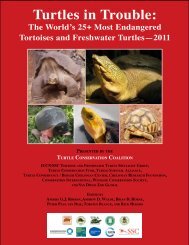WCS Annual Report 2012 - Wildlife Conservation Society
WCS Annual Report 2012 - Wildlife Conservation Society
WCS Annual Report 2012 - Wildlife Conservation Society
You also want an ePaper? Increase the reach of your titles
YUMPU automatically turns print PDFs into web optimized ePapers that Google loves.
financial report<br />
2<br />
The last decade has been a period of transformation and growth for the <strong>Wildlife</strong><br />
<strong>Conservation</strong> <strong>Society</strong>. At the same time, we stayed true to our commitment to maintain<br />
positive operating margins and set aside funds each year to support our increasing<br />
plant infrastructure and technology needs. We closed the 2011-12 Fiscal Year with<br />
operating revenues totaling $223.3 million – $15 million and 7 percent higher than<br />
the prior year. Operations ended the year with a small surplus of $1.7 million for<br />
the ninth consecutive year of positive results.<br />
Our investments in programmatic and fundraising leadership<br />
and capacity-building in species, landscapes, science, and global<br />
wildlife health are achieving measurable results and increasing<br />
sustainable funding. Programmatic support from private contributions,<br />
federal agencies, foreign aid, and multi/bilateral funding<br />
have likewise fueled continued growth in education, global conservation,<br />
zoo-based programs, and wildlife health.<br />
In Fiscal Year <strong>2012</strong>, contributions and grants from individuals<br />
and foundations, federal and state agencies, foreign aid, and multilateral<br />
organizations totaled $98.5 million, a healthy 4 percent<br />
increase from the prior year. These sources provided 44 percent<br />
of all operating revenue. Federal grant support of our global<br />
programs through the United States Agency for International<br />
Development (USAID), the U.S. Fish and <strong>Wildlife</strong> Service (USFWS)<br />
and other agencies totaled $31.6 million, nearly eight times the<br />
funding received from these sources a decade ago.<br />
The establishment of <strong>WCS</strong>-Europe and the opening of a Brussels<br />
office have created new opportunities with European donors and<br />
agencies. The development of the <strong>WCS</strong> Species Program, which<br />
links global conservation with zoo-based programs, is also creating<br />
new revenue sources for <strong>WCS</strong>.<br />
We have continued to focus on earned revenue growth by increasing<br />
park attendance and income through our new operating<br />
model focused on improving the visitor experience. In Fiscal Year<br />
<strong>2012</strong>, <strong>WCS</strong> attendance increased 11 percent (436,000) above last<br />
year to 4.47 million visitors. This was in line with projections,<br />
thanks in part to extremely favorable weather throughout winter<br />
and spring. Income from gate admissions, exhibits, membership,<br />
and visitor services (food, merchandise, and parking) grew 14<br />
percent and exceeded $75 million. This success is the product of<br />
on-line marketing, discounting, and promotion of higher value<br />
tickets and memberships. Audience-driven revenue sources were<br />
one third of total operating income in Fiscal Year <strong>2012</strong>.<br />
<strong>WCS</strong> is using business intelligence and consumer research to<br />
maximize admission and other audience-driven revenue, while<br />
supporting free visitation times at the Bronx Zoo and the New<br />
York Aquarium. Per capita earned revenues continue to increase,<br />
particularly at the Bronx Zoo, thanks to a proactive pricing<br />
strategy and sales management in the park and online. Membership<br />
is a key part of this initiative and results have been positive,<br />
with strong growth in online activity.<br />
The City of New York provided a total of $22.1 million for zoo<br />
and aquarium operations, $1.6 million less than the prior year.<br />
This is due to improved earned income at the City Zoos, which<br />
reduced the Department of Parks and Recreation’s reimbursement<br />
commitment by $1.2 million compared to last year. This represents<br />
a continued trend of lower costs for the city thanks to <strong>WCS</strong>’s<br />
active pricing, revenue strategies, and tight expense management.<br />
The lower value of utilities provided by the city for the Bronx Zoo<br />
and the New York Aquarium also contributed to the variance.<br />
29<br />
financial report







![RaLand / SeaScape [PDF] - Wildlife Conservation Society](https://img.yumpu.com/49974326/1/190x245/raland-seascape-pdf-wildlife-conservation-society.jpg?quality=85)









